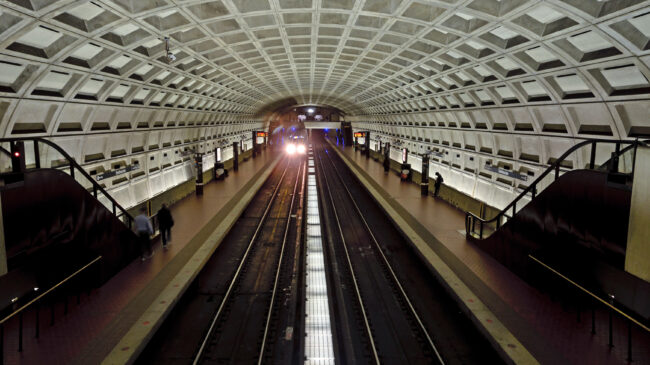This week’s suspension of Washington Metropolitan Area Transit Authority (WMATA) Series 7000 rail cars is a reminder to policymakers of some of the limits of rail technology as a cost-effective mode of metro area travel. The problems are also an opportunity for Congress and the Biden administration to reflect on these limitations before enacting the Senate-passed infrastructure bill, which looks to provide billions of additional dollars for rail transit.
After multiple derailments, the Washington Metrorail Safety Commission ordered that WMATA take its newest cars out of service. Because the Kawasaki-manufactured Series 7000 cars account for about 60% of the agency’s rolling stock, the suspension is causing a reduction in train frequencies, with 30-minute headways now the norm on most lines, compared to the usual 10-12 minute frequencies.
If the 7000 series cars stay off tracks for a prolonged period, it could reverse the ridership gains WMATA has achieved as the COVID-19 pandemic recedes. As expected during the COVID-19 pandemic and shutdowns, WMATA’s average daily ridership fell about 95% between February and April of 2020. But, by this August, ridership had surpassed one-quarter of pre-pandemic levels.
The rail system is dependent on its 7000-series cars because previous vehicles had to be retired early. Series 4000 cars delivered in 1991 and series 5000 cars delivered in 2001, were retired in 2017 and 2018 respectively due to poor reliability. In 2020, WMATA took its 6000 series cars out of service indefinitely after two train separation incidents (although some of these cars have returned to service recently).
Now with the 7000-series cars sidelined, the system is totally dependent on older 2000- and 3000-series cars delivered in the 1980s. WMATA’s experience suggests that newer rolling stock is less reliable than cars built decades ago. And this type of problem is not limited to Washington, DC:
- The New York Metropolitan Transportation Authority (MTA) took about 300 new R179 subway cars out of service in early 2020 due to cars separating during train operations. Inspectors found that the incident occurred because a spiral pin was missing from Bombardier’s draft gear assembly. The train cars also experienced “uncommanded door openings” and anomalies in their side collision post welds. When they were removed from service the R179 cars were less than four years old.
- In Boston, the Massachusetts Bay Transportation Authority’s (MBTA) new Red and Orange line cars, built by China Railway Rolling Stock Corporation, were removed from service after a March 2021 derailment. As the Boston Globe reported: “This is far from the MBTA’s first struggle with new subway cars. More than 20 years ago, new Green Line cars were prone to derailment and ultimately took years to be fully introduced. The MBTA was also sharply critical in the mid-2000s of contractor Siemens because of manufacturing delays with the current roster of Blue Line cars.”
- The San Francisco Bay Area Rapid Transit (BART) system instructed Bombardier to slow down deliveries of 775 new “Fleet of the Future” cars due to software glitches and problems with the trains’ wheels that caused more frequent breakdowns relative to older rolling stock.
- As I reported in May, the new Honolulu Authority for Rapid Transit (HART) elevated rail system was unable to begin service because the wheels on its Hitachi train cars were not wide enough to move through track crossings at full speed. This issue remained unresolved as of October 2021.
Modern transit cars are complicated machines that are typically custom-built according to the varying needs of different metro systems or even specific lines within those systems. As a result, they are very expensive—often costing $2 million or more each—and subject to reliability issues.
This contrasts sharply with rubber tire vehicles, i.e., cars, vans, and buses, that can be mass-produced and employed across multiple cities, states, and countries. While it is true that mass-produced vehicles are also subject to recall, it is also easier to temporarily or permanently replace fleets of mass-produced vehicles that experience operational problems.
At the federal level, the bipartisan infrastructure bill passed by the Senate includes $15 billion of new capital investment grants for public transportation. According to the Department of Transportation, these grants can be used for “heavy rail, commuter rail, light rail, streetcars, and bus rapid transit.”
Given both the expense of rail transit rolling stock and the widespread reliability issues that plague them, Congress should consider directing more capital funding to buses.
In most cases, Bus Rapid Transit services can provide sufficient capacity and similar travel times to light rail and urban subway systems, at a much lower cost. If the infrastructure bill is enacted as is, the U.S. Department of Transportation should take the reliability problems of rail cars into account as it considers grant applications.
Update 10/22: This column previously said that all 6000 series cars were out of service but some of these cars have returned to service.

